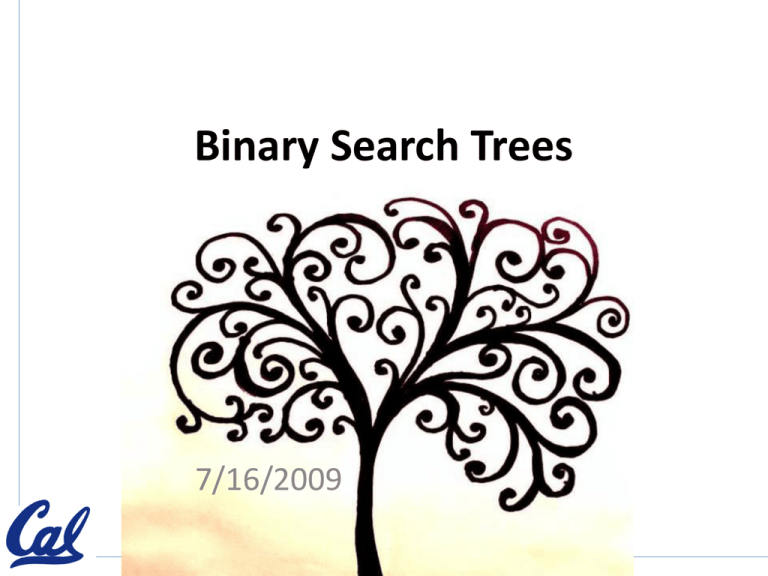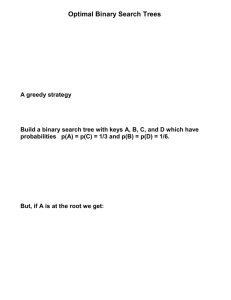Binary Search Trees 7/16/2009
advertisement

Binary Search Trees 7/16/2009 Important Dates • Project 2 due – DESIGN, DESIGN, DESIGN!!! – You may have 0 or 1 partner. • NO EXCEPTIONS! – Friday 7/24/2009 – 10pm • Project 2 – time to work in lab – Monday 7/20/2009 • Midterm Review – Saturday 7/26/2009 – 1-4pm in 306 Soda • Midterm 2 – Tuesday 7/28/2009 – 5-6pm in 10 Evans Topics • • • • • Maximally balanced trees Big-Oh of tree operations Binary Search Tree remove Stacks Map Maximally Balanced? YES Maximally Balanced? NO NULL Maximally Balanced? YES Another way to implement trees! 10 5 15 3 7 13 18 2 Maximally Balanced Trees – WHY? 10 5 15 3 7 18 A Better Tree Implementation (don’t use the 0 index) Left Child at 2n Right Child at 2n + 1 0 10 5 15 3 7 1 2 3 4 5 18 6 7 8 9 10 How many elements are in a balanced tree? Assume h = height 0 8 4 12 2 6 10 14 1 3 5 7 9 11 13 15 1 2 5 9 10 11 12 3 4 6 7 8 13 14 15 // Take the log of both sides // Remember: What is the run-time for find in this tree? What is the run-time for find in this tree? Running Times • In a perfectly (full) balanced binary tree with height/depth h, the number of nodes n = 2(h+1) - 1. • Therefore, no node has depth greater than log2 n. • The running times of find(), insert(), and remove() are all proportional to the depth of the last node encountered, so they all run in O(log n) worst-case time on a perfectly balanced tree. Running Times • What’s the running time for this binary tree? • The running times of find(), insert(), and remove() are all proportional to the depth of the last node encountered, but d = n – 1, so they all run in O(n) worst-case time. Running Times • The Middle ground: reasonably well-balanced binary trees – Search tree operations will run in O(log n) time. • You may need to resort to experiment to determine whether any particular application will use binary search trees in a way that tends to generate balanced trees or not. Running Times • Binary search trees offer O(log n) performance on insertions of randomly chosen or randomly ordered keys (with high probability). • Technically, all operations on binary search trees have Theta(n) worst-case running time. • Algorithms exists for keeping search trees balanced. e.g.,2-3-4 trees. Binary Search Tree Remove http://www.cs.jhu.edu/~goodrich/dsa/trees/btr ee.html Binary Tree Remove Delete a node given a key, if a node exists. 1. Find a node with key k using the same algorithm as find(). 2. Return null if k is not in the tree; 3. Otherwise, let n be the first node with key k. If n has no children, detach it from its parent and throw it away. Binary Tree Remove 4. If n has one child, move n‘s child up to take n's place. n's parent becomes the parent of n's child, and n's child becomes the child of n's parent. Dispose of n. Deletion 5. If n has two children: – Let x be the node in n's right subtree with the smallest key. (the inorder successor) Remove x; since x has the minimum key in the subtree, x has no left child and is easily removed. – Replace n's entry with x's entry. x has the closest key to k that isn't smaller than k, so thebinary search tree invariant still holds. Stack • push : put something on top of the stack • pop: take something from the top of the stack • peak: look at the thing on the top of the stack Stack Based Pre-Order Traversal Map is an Interface KEY Jonathan Kaushik David George Colleen VALUE Hot pink Green Blue Green Yellow Map Interface • get : returns the value for that key • put: takes a key and a value and adds them to the map. • containsKey : returns a boolean



